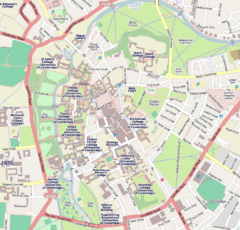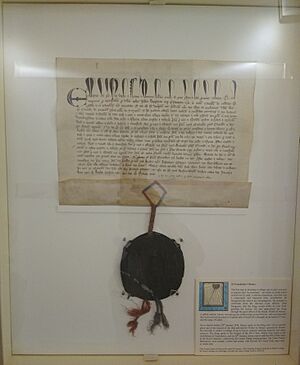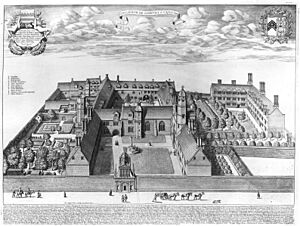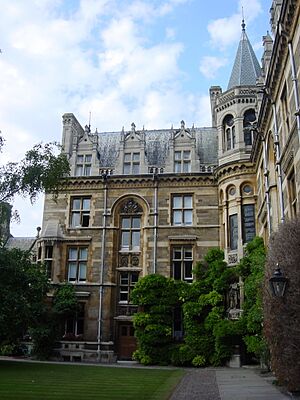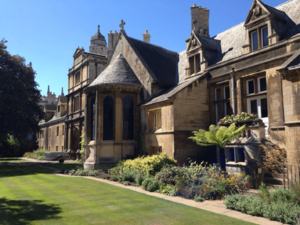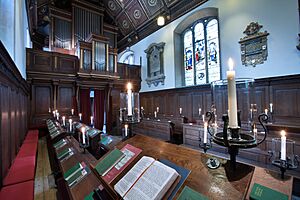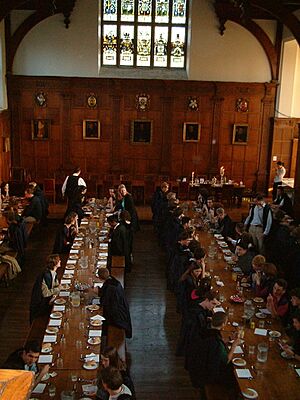Gonville and Caius College, Cambridge facts for kids
Quick facts for kids Gonville and Caius College |
|||||
|---|---|---|---|---|---|
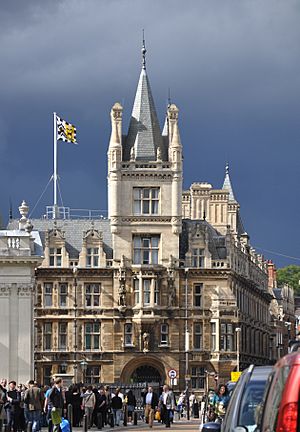
Gonville & Caius College from King's Parade
|
|||||
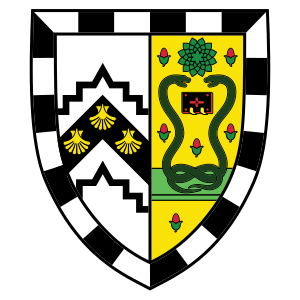
Arms of Gonville & Caius College
|
|||||
|
|
|||||
| University | Cambridge University | ||||
| Location | Trinity Street (map) | ||||
| Coordinates | 52°12′21″N 0°07′04″E / 52.2059°N 0.1179°E | ||||
| Abbreviation | CAI | ||||
| Founders |
|
||||
| Established | 1348, refounded 1557 | ||||
| Previous names |
|
||||
| Sister college | Brasenose College, Oxford | ||||
| Master | Pippa Rogerson | ||||
| Undergraduates | 618 (2022-23) | ||||
| Postgraduates | 256 (2022-23) | ||||
| Map | |||||
Gonville and Caius College, often called Caius (pronounced KEEZ), is a college that belongs to the University of Cambridge in England. It was started in 1348 by Edmund Gonville. This makes it the fourth-oldest college at Cambridge University. It is also one of the richest colleges. In 1557, it was re-established by a former student named John Caius.
Many students from Caius College have achieved great things. This includes fifteen Nobel Prize winners. This is the second-highest number of Nobel winners from any college at Oxbridge (Oxford or Cambridge). Some streets in Cambridge are named after former students from Gonville and Caius. The college has also helped start other colleges, like Trinity Hall and Darwin College.
Contents
College History
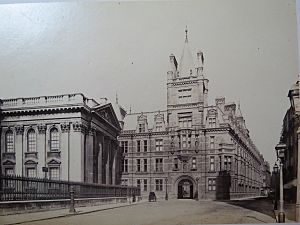
The college began in 1348 as Gonville Hall. It was founded by Edmund Gonville, a church leader from a French family. Gonville was wealthy enough to lend money to King Edward III. The king then made him a "King's Clerk."
With help from Sir Walter Manny, Gonville asked the king to allow him to start a college for 20 scholars in Cambridge. In January 1348, King Edward III agreed. This makes Gonville and Caius the fourth-oldest college still active at Cambridge.
Gonville passed away three years later, in 1351. The college then faced money problems. William Bateman, the Bishop of Norwich, stepped in. He moved the college to its current spot in central Cambridge. He also started his own college, Trinity Hall, nearby. Gonville Hall was renamed The Hall of the Annunciation of the Blessed Virgin Mary.
By the 1500s, the college needed repairs. In 1557, it was re-established by a special paper from the King. This was done by a former student named John Caius. Caius had studied at the college from 1529 to 1533. He later studied medicine in Italy. When he returned to England, Caius became a famous doctor. He worked for King Edward VI, Queen Mary I, and later Queen Elizabeth I.
John Caius became the Master of the college in 1559. He held this job until just before he died in 1573. He gave a lot of money to the college and made its buildings much bigger. Caius did not take any payment for his work. He did set some unusual rules for who could join the college. He also built a special three-sided court, Caius Court. This was to make sure the air stayed fresh. Caius helped the college become famous for medicine around the world.
By 1630, the college had grown a lot, with about 25 teachers and 150 students. The number of students and teachers went down for a while. But it returned to the 1630 level by the early 1800s. Since then, Gonville and Caius has grown even more. It now has one of the largest groups of undergraduate students at Cambridge. In 1979, the college welcomed women as teachers and students for the first time. Today, it has over 110 teachers, more than 700 students, and about 200 staff members.
Gonville and Caius is one of the richest colleges at Cambridge. Its money fund was £221 million in 2018. The current leader, called the 43rd Master, is Pippa Rogerson. She was appointed in 2018.
College Buildings and Grounds
Old Courts
The first buildings on the college's current site were built in 1353. This is when Bateman built Gonville Court. The college chapel was added in 1393. The Old Hall and the Master's Lodge followed later. Most of the stone for the college came from Ramsey Abbey. Gonville and Caius has the oldest college chapel that has been used continuously in either Oxford or Cambridge. The chapel is in the middle of the college. This shows how important religion was when the college was founded.
When Caius re-established the college, it was made bigger and more modern. In 1565, the building of Caius Court began. Caius also planted trees in what is now called Tree Court.
Caius also built the college's three special gates. These gates show the journey of a student's academic life:
- The Gate of Humility is near the Porters' Lodge. Students walk through it when they first join the college.
- The Gate of Virtue is between Tree Court and Caius Court. Students walk through this gate often during their studies.
- The Gate of Honour leads to the nearby Senate House. Students walk through this gate to get their degrees.
The Gate of Honour is only used for special events, like graduation.
The buildings in Gonville Court were updated in the 1750s. The Old Library and Hall were designed in 1854. In the Hall, there is a college flag. This flag was flown at the South Pole in 1912 by Cambridge explorer Edward Wilson. Gonville Court is the oldest part of the college. New lecture rooms were finished in 1884.
West Road Site
Caius owns a lot of land between West Road and Sidgwick Avenue. The modern Harvey Court was built here in 1961. It is named after William Harvey. Next to Harvey Court is the Stephen Hawking Building. It opened in 2006 for first-year students. This building has rooms for 75 students and eight teachers. It also has rooms for conferences.
Other buildings here provide homes for older students. There is also a day care and study rooms. The college also owns large gardens. It owns the land where the Squire Law Library has been since 1995.
Libraries
Caius has one of the biggest libraries in Oxbridge. It is in the Cockerell Building. The college moved its library there in 1996 after a big renovation.
Other Places to Live
Across Trinity Street, the college has St Michael's Court. This was finished in the 1930s. The college also owns several houses around Cambridge. Some second-year students live on Mortimer Road and Gresham Road. Graduate students live on Harvey Road and St Paul's Road.
Gardens and Sports Fields
The Fellows' garden is near Harvey Court. The college's large sports fields are on Barton Road. This is a short walk from Harvey Court.
College Traditions
Gonville and Caius College has many traditions. Students can eat dinner in the Hall six nights a week. There are two dinner times. About 150–200 students usually attend. Formal Hall requires students to wear a special gown. Teachers sit at a high table. Before dinner, a blessing is said in Latin:
Benedic, Domine, nobis et donis tuis quae ex largitate tua sumus sumpturi; et concede ut, ab iis salubriter enutriti, tibi debitum obsequium praestare valeamus, per Jesum Christum dominum nostrum; mensae caelestis nos participes facias, Rex aeternae gloriae.
Students are expected to eat dinner at least 31 times each term. This is called the minimum dining requirement.
Like most colleges at Oxford and Cambridge, only the teachers are allowed to walk on the grass.
The college also has a system called exeats. These are official permissions to leave the college. Students who want to stay away from college overnight must get permission from their tutors.
Student Life
Caius Boat Club is the college's rowing club. The men's top team was unbeaten in 2010/11 and 2011/2012. They are currently first in the May Bumps race.
Caius Jazz events happen most terms in the college bar. They invite famous jazz musicians to play. Students from music schools in London also play.
The Caius May Ball is a big all-night party held every two years in June.
Squires is a society for male students. The female equivalent is called the Cupids.
Choir
The Gonville and Caius Choir was started by composer Charles Wood in the late 1800s. The choir travels to other countries and makes recordings. The choir is made up of students from Caius and other Cambridge colleges.
Student Union
The college's student union is called Gonville and Caius Student Union (GCSU).
Famous Former Students

Since it was founded, Gonville and Caius has had many famous former students. This includes 15 Nobel Prize winners:
Nobel Prize Winners
- 1932 Charles Scott Sherrington – a scientist who studied the nervous system.
- 1935 James Chadwick – a physicist who discovered the neutron.
- 1945 Howard Florey – helped develop penicillin, a medicine.
- 1954 Max Born – a physicist.
- 1962 Francis Crick – helped discover the structure of DNA.
- 1972 John Hicks – an economist.
- 1974 Antony Hewish – an astronomer.
- 1976 Milton Friedman – an economist.
- 1977 Nevill Francis Mott – a physicist.
- 1984 Richard Stone – an economist.
- 2001 Joseph Stiglitz – an economist.
- 2008 Roger Tsien – a chemist.
- 2013 Michael Levitt – a chemist.
- 2016 Michael Kosterlitz – a physicist.
- 2019 Peter J. Ratcliffe – a doctor and scientist.
Images for kids
-
Stained-glass window in dining hall, remembering Charles Scott Sherrington
-
Stained-glass window in dining hall, remembering John Venn, who created the Venn diagram
-
Stained-glass window in dining hall, remembering Francis Crick, who helped discover the structure of DNA
-
View from Great St Mary's Church
See also
 In Spanish: Gonville and Caius College para niños
In Spanish: Gonville and Caius College para niños
- Caius Boat Club
- Gonville & Caius Association Football Club
- John of Padua
- List of organ scholars
- Listed buildings in Cambridge (west)
- Sir Ronald Fisher window


